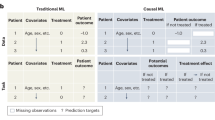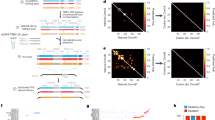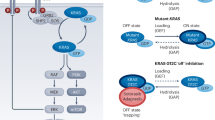Abstract
The optimal evaluation of molecularly targeted anticancer agents requires the integration of pharmacodynamic assays into early clinical investigations. Phase '0' trials conducted under the new Exploratory Investigational New Drug Guidance from the US Food and Drug Administration can provide a platform to establish the feasibility of assays for target modulation in human samples, evaluate biomarkers for drug effects and provide pharmacokinetic data. Phase 0 trials could facilitate rational drug selection, identify therapeutic failures early, and might compress timelines for anticancer drug development. We expect that such trials will become a routine part of early-phase oncological drug development in the future.
This is a preview of subscription content, access via your institution
Access options
Subscribe to this journal
Receive 12 print issues and online access
$209.00 per year
only $17.42 per issue
Buy this article
- Purchase on Springer Link
- Instant access to full article PDF
Prices may be subject to local taxes which are calculated during checkout



Similar content being viewed by others
References
US Food and Drug Administration. Guidance for Industry, Investigators, and Reviewers. US Food and Drug Administration, [online] (2006).
Kola, I., Landis, J. Can the pharmaceutical industry reduce attrition rates? Nature Rev. Drug Discov. 3, 711–715 (2004).
Johnson, J. I. et al. Relationships between drug activity in NCI preclinical in vitro and in vivo models and early clinical trials. Br. J. Cancer 84, 1424–1431 (2001).
Olson, H., Betton, G., Robinson D . et al. Concordance of the toxicity of pharmaceuticals in humans and in animals. Regul. Toxicol. Pharmacol. 32, 56–67 (2000).
Tomaszewski, J. E., Smith, A. C., Covey, J. M., Donohue, S. J., Rhie, J. K. & Schweikart, K. M. in Anti-Cancer Drug Design (ed. Baguley, B. C.) Chpt 17, 301–328 (San Diego, Academic Press, 2001).
Tomaszewski, J. E., Doroshow, J. H. in Molecular Targets in Oncology (ed. Antman, K.) (Humana Press, Totowa, USA, in the press).
Fox, E., Curt, G. A. & Balis, F. M. Clinical trial design for target-based therapy. Oncologist. 7, 401–409 (2002).
Millar, A. W., Lynch, K. P. Rethinking clinical trials for cytostatic drugs. Nature Rev. Cancer. 3, 540–545 (2003).
Rothenberg, M. L., Carbone, D. P. & Johnson, D. H. Improving the evaluation of new cancer treatments: challenges and opportunities. Nature Rev. Cancer. 3, 303–309 (2003).
Kummar, S., Gutierrez, M. E., Doroshow, J. H. & Murgo, A. J. Drug development in oncology: classical cytotoxics and molecularly targeted agents. Br. J. Clin. Pharmacol. 62, 15–26 (2006).
Workman, P. et al. Minimally invasive pharmacokinetic and pharmacodynamic technologies in hypothesis-testing clinical trials of innovative therapies. J. Natl Cancer Inst. 98, 580–598 (2006).
Parulekar, W. R., Eisenhauer, E. A. Phase I trial design for solid tumor studies of targeted, non-cytotoxic agents: theory and practice. J. Natl. Cancer Inst. 96, 990–997 (2004).
Bartlett, J. M. Pharmacodiagnostic testing in breast cancer: focus on HER2 and trastuzumab therapy. Am. J. Pharmacogenomics 5, 303–315 (2005).
Lehmann, F., Lacombe, D., Therasse, P., Eggermont A. M. M. Integration of translational research in the european organization for research and treatment of cancer research (EORTC) clinical trial cooperative group mechanisms. J. Transl. Med. 1, 2 (2003).
Hidalgo, M., and Eckhardt, S. G. Matrix metalloproteinase inhibitors: how can we optimize their development? Ann. Oncol. 12, 285–287 (2001).
Moore, M. J. et al. Comparison of gemcitabine versus the matrix metalloproteinase inhibitor BAY 12–9566 in patients with advanced or metastatic adenocarcinoma of the pancreas: a phase III trial of the National Cancer Institute of Canada Clinical Trials Group. J. Clin. Oncol. 21, 3296–3302 (2003).
Van Den Bossche, B., Van de Wiele, C. Receptor imaging in oncology by means of nuclear medicine: current status. J. Clin. Oncol. 22, 3593–3607 (2004).
Sun, H. et al. Imaging the pharmacokinetics of [F-18]FAU in patients with tumors: PET studies. Cancer Chemother. Pharmacol. 57, 343–348 (2006).
Liu, G. et al. Dynamic contrast-enhanced magnetic resonance imaging as a pharmacodynamic measure of response after acute dosing of AG-013736, an oral angiogenesis inhibitor, in patients with advanced solid tumors: results from a phase I study. J. Clin. Oncol. 23, 5464–5473 (2005).
Collins, J. M. Imaging and other biomarkers in early clinical studies: one step at a time or re-engineering drug development? J. Clin. Oncol. 23, 5417–5419 (2005).
Collins, J. M., Grieshaber, C. K. & Chabner, B. A. Pharmacologically guided phase I clinical trials based upon preclinical drug development. J. Natl. Cancer Inst. 82, 1321–1326 (1990).
Acknowledgements
This project has been funded in whole or in part with federal funds from the US National Cancer Institute, National Institutes of Health. The content of this publication does not necessarily reflect the views or policies of the US Department of Health and Human Services, nor does any mention of trade names, commercial products or organizations imply endorsement by the US Government. This research was supported by the Division of Cancer Treatment and Diagnosis and the Center for Cancer Research of the National Cancer Institute.
Author information
Authors and Affiliations
Corresponding author
Ethics declarations
Competing interests
The authors declare no competing financial interests.
Related links
Rights and permissions
About this article
Cite this article
Kummar, S., Kinders, R., Rubinstein, L. et al. Compressing drug development timelines in oncology using phase '0' trials. Nat Rev Cancer 7, 131–139 (2007). https://doi.org/10.1038/nrc2066
Issue Date:
DOI: https://doi.org/10.1038/nrc2066
This article is cited by
-
The Future Glioblastoma Clinical Trials Landscape: Early Phase 0, Window of Opportunity, and Adaptive Phase I–III Studies
Current Oncology Reports (2023)
-
Evaluation of two-stage designs of Phase 2 single-arm trials in glioblastoma: a systematic review
BMC Medical Research Methodology (2022)
-
Machine learning-enabled predictive modeling to precisely identify the antimicrobial peptides
Medical & Biological Engineering & Computing (2021)
-
Adaptive Biomarker Population Selection in Phase III Confirmatory Trials with Time-to-Event Endpoints
Statistics in Biosciences (2018)
-
Evolution of early phase clinical trials in oncology
Journal of Molecular Medicine (2018)



